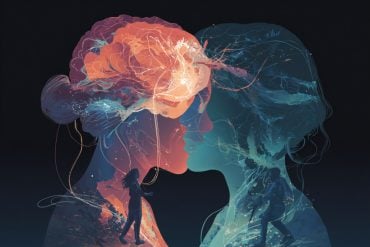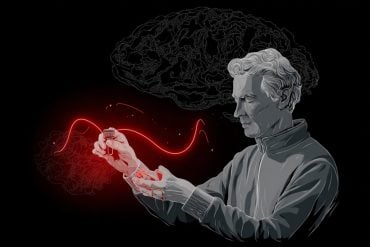Summary: A new study reveals professional dancers’ brains react more quickly to musical changes than professional musicians. EEG data reveals dancers display stronger synchronization at a lower theta frequency, which is linked to emotional and memory processing. The study backs up previous findings that indicate both the auditory and motor cortices of dancers develop in unique ways.
Source: University of Helsinki.
Neuroscience has studied music for decades, and it has been found to activate both the cortical and deeper brain areas. Neuroscience of dance, instead, is a young but quickly growing field.
In her doctoral dissertation, Master of Science Hanna Poikonen developed methods for understanding the processes that dance generates in the cortex at the Cognitive Brain Research Unit of University of Helsinki. In her research project, she compared the brain functions of professional dancers and musicians to people with no experience of dance or music as they watched recordings of a dance piece.
According to the results, the brain activity of the dancers was different from that of musicians and the control group during sudden changes in the music, long-term listening of music and the audio-visual dance performance.
“The dancers’ brains reacted more quickly to changes in the music. The change was apparent in the brain as a reflex before the dancer is even aware of it at a conscious level,” Poikonen says.
“I also found that dancers displayed stronger synchronisation at the low theta frequency. Theta synchronisation is linked to emotion and memory processes which are central to all interpersonal interaction and self-understanding.”
These results support the earlier findings indicating that the auditory and motor cortex of dancers develops in a unique way.

“Studies of professional dancers and musicians have highlighted the importance of multimodal interaction and motor-related brain regions in cerebral processing of dance and music,” Poikonen says.
In her research, she used the novel EEG methods that she had developed: event-related potentials to investigate the influence of fast changes of musical features in the brain in a short timescale and changes in phase synchrony between two electrode channels when investigating cortical dynamics during observation of dance and music over a longer timescale.
These methods could be used in the development and assessment of therapy as well.
“The methods could be applied in estimating the efficiency and developing further expressive therapies, such as dance-movement therapy, as a part of holistic treatment plan for conditions such as Parkinson’s disease, dementia, autism, and pain and mood disorders.”
Hanna Poikonen, M.Sc. will defend the doctoral dissertation entitled “Dance on Cortex: ERPS and phase synchrony in dancers and musicians during a contemporary dance piece” in the Faculty of Medicine, University of Helsinki, on 11 May 2018 at 12:00. The public examination will take place at the Main Building of University if Helsinki, lecture room 12. Address: Fabianinkatu 33, 00170 Helsinki.
Source: Felix Ströckens – University of Helsinki
Publisher: Organized by NeuroscienceNews.com.
Image Source: NeuroscienceNews.com image is in the public domain.
Original Research: Hanna Poikonen’s dissertation thesis is available online.
[cbtabs][cbtab title=”MLA”]University of Helsinki “Dancers’ Brains React Quickly to Changes in Music and Display Brain Frequencies Linked to Emotion and Memory Processes.” NeuroscienceNews. NeuroscienceNews, 4 May 2018.
<https://neurosciencenews.com/dancer-brain-music-memory-emotion-8965/>.[/cbtab][cbtab title=”APA”]University of Helsinki (2018, May 4). Dancers’ Brains React Quickly to Changes in Music and Display Brain Frequencies Linked to Emotion and Memory Processes. NeuroscienceNews. Retrieved May 4, 2018 from https://neurosciencenews.com/dancer-brain-music-memory-emotion-8965/[/cbtab][cbtab title=”Chicago”]University of Helsinki “Dancers’ Brains React Quickly to Changes in Music and Display Brain Frequencies Linked to Emotion and Memory Processes.” https://neurosciencenews.com/dancer-brain-music-memory-emotion-8965/ (accessed May 4, 2018).[/cbtab][/cbtabs]
Abstract
Functional MRI in the Nile crocodile: a new avenue for evolutionary neurobiology
Crocodilians are important for understanding the evolutionary history of amniote neural systems as they are the nearest extant relatives of modern birds and share a stem amniote ancestor with mammals. Although the crocodilian brain has been investigated anatomically, functional studies are rare. Here, we employed functional magnetic resonance imaging (fMRI), never tested in poikilotherms, to investigate crocodilian telencephalic sensory processing. Juvenile Crocodylus niloticus were placed in a 7 T MRI scanner to record blood oxygenation level-dependent (BOLD) signal changes during the presentation of visual and auditory stimuli. Visual stimulation increased BOLD signals in rostral to mid-caudal portions of the dorso-lateral anterior dorsal ventricular ridge (ADVR). Simple auditory stimuli led to signal increase in the rostromedial and caudocentral ADVR. These activation patterns are in line with previously described projection fields of diencephalic sensory fibres. Furthermore, complex auditory stimuli activated additional regions of the caudomedial ADVR. The recruitment of these additional, presumably higher-order, sensory areas reflects observations made in birds and mammals. Our results indicate that structural and functional aspects of sensory processing have been likely conserved during the evolution of sauropsids. In addition, our study shows that fMRI can be used to investigate neural processing in poikilotherms, providing a new avenue for neurobiological research in these critical species.






